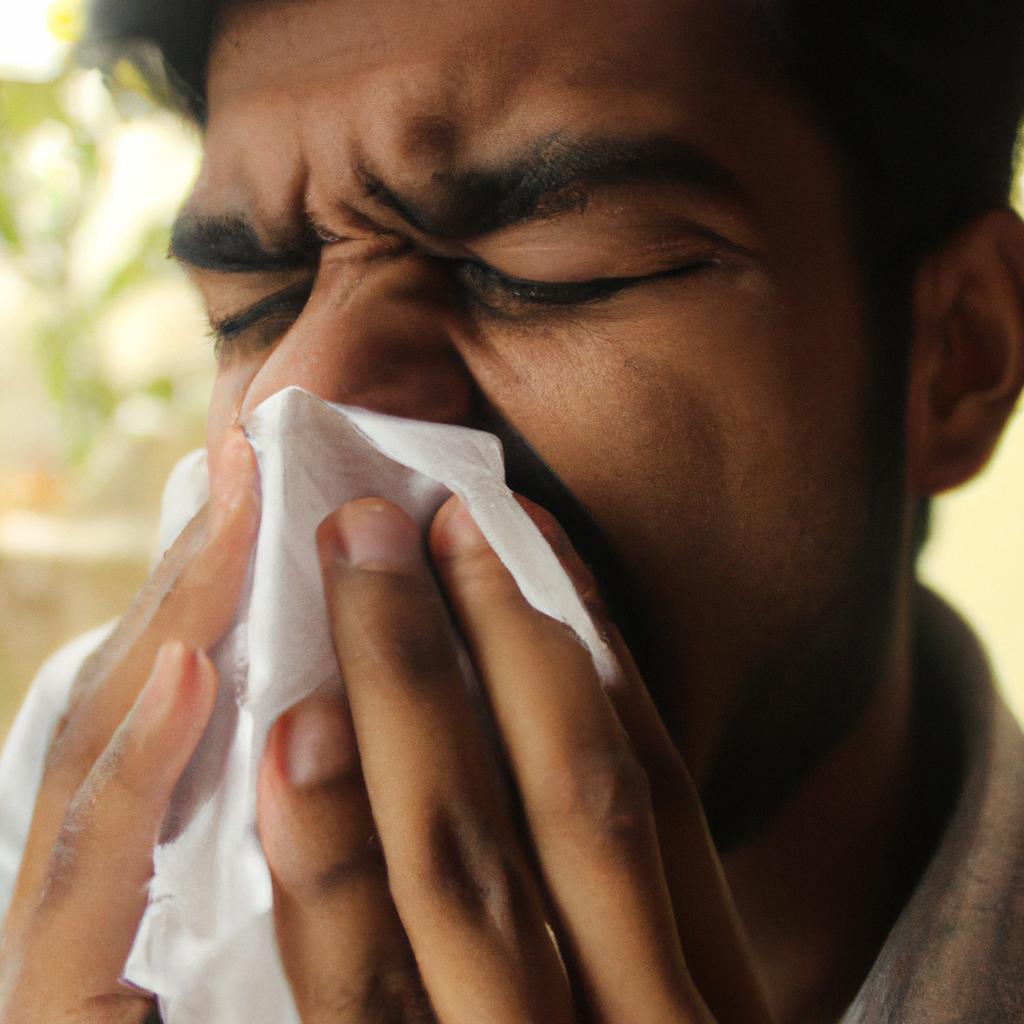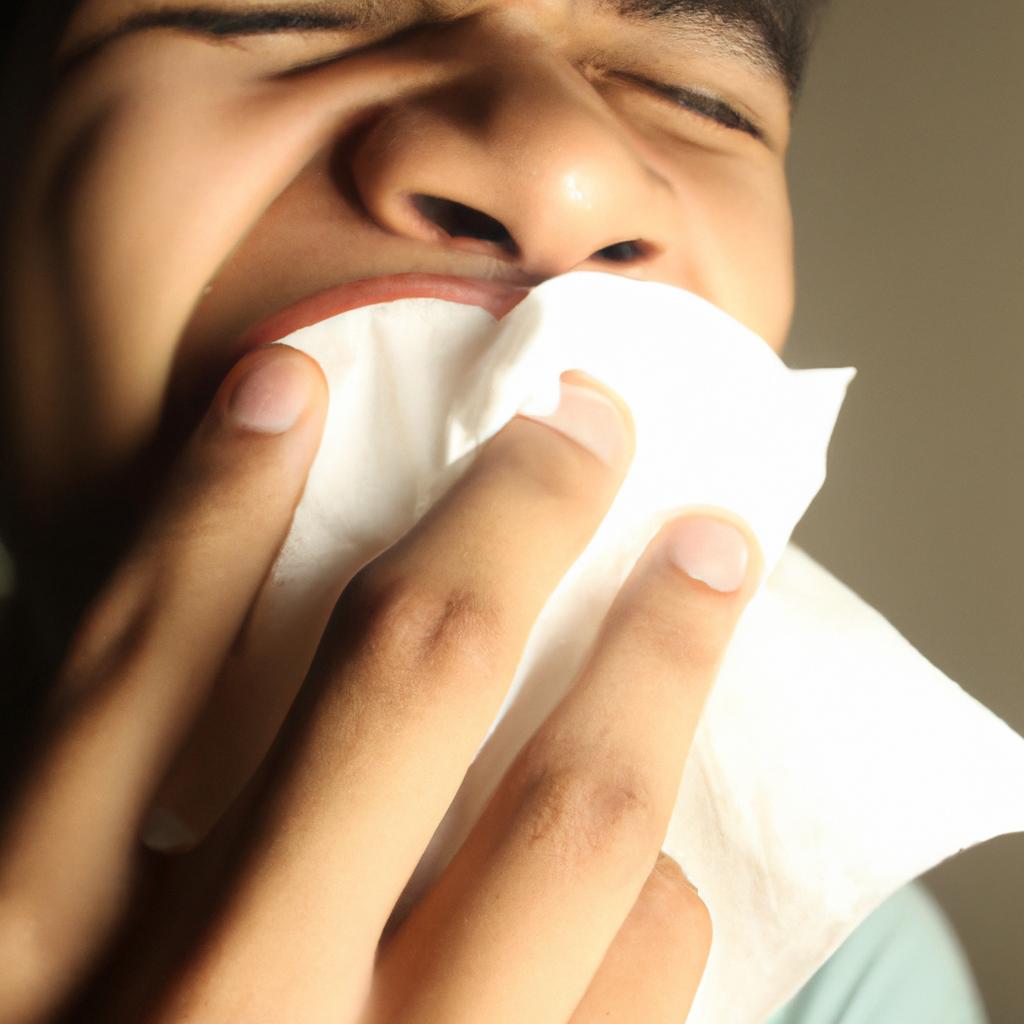Allergic reactions are a common health concern affecting millions of individuals worldwide. The manifestation of allergy symptoms can range from mild discomfort to severe life-threatening conditions, making it crucial for individuals to be aware and knowledgeable about these health conditions and diseases. For instance, imagine an individual who suddenly experiences uncontrollable sneezing, watery eyes, and itching after being exposed to pollen in the air. This hypothetical case demonstrates how allergies can significantly impact an individual’s quality of life and highlights the importance of understanding various aspects related to allergic reactions.
This comprehensive guide aims to provide readers with valuable insights into different types of allergies, their causes, symptoms, and potential treatment options. By examining the underlying mechanisms behind allergic reactions, this article seeks to equip readers with a better understanding of why certain substances trigger adverse responses within the body. Furthermore, it will explore the wide array of allergens that exist in our environment, such as pollen, pet dander, dust mites, food items, medications, and insect stings. Understanding these diverse triggers is essential for individuals seeking effective strategies to manage or prevent allergic reactions.
Moreover, this article will delve into various allergy symptoms that individuals may encounter across different organ systems. From respiratory manifestations like coughing and wheezing to dermatological conditions like hives and eczema, allergy symptoms can manifest in a variety of ways. By recognizing these symptoms, individuals can seek appropriate medical attention and take necessary steps to manage their allergies effectively.
In terms of treatment options, this guide will provide an overview of both pharmacological and non-pharmacological approaches. Antihistamines, corticosteroids, and immunotherapy are among the commonly prescribed medications for managing allergy symptoms. Additionally, lifestyle modifications such as avoiding allergens, using air purifiers, and maintaining good hygiene practices can also play a crucial role in preventing allergic reactions.
Furthermore, it is important to address potential complications that may arise from allergic reactions. Anaphylaxis, a severe and potentially life-threatening allergic reaction, requires prompt medical intervention. Understanding the signs and symptoms of anaphylaxis is vital in order to administer immediate treatment with epinephrine (adrenaline) through auto-injectors (e.g., EpiPen).
Lastly, this comprehensive guide will emphasize the importance of seeking professional medical advice when dealing with allergies. Allergists or immunologists specialize in diagnosing and treating various types of allergies. They can conduct tests such as skin prick tests or blood tests to determine specific allergens responsible for an individual’s allergic reactions.
In conclusion, allergies are prevalent health concerns that significantly impact individuals’ well-being. This comprehensive guide aims to empower readers with knowledge about different types of allergies, their causes, symptoms, treatments, prevention strategies, and potential complications. By understanding these aspects surrounding allergic reactions, individuals can better manage their allergies and improve their overall quality of life.
Types of Allergies
Imagine a scenario where a young child develops skin rashes and experiences difficulty breathing after being in contact with a cat. This case highlights the presence of allergies, which are hypersensitivity reactions that occur when the immune system overreacts to substances known as allergens. Allergies can manifest in various forms, affecting millions of individuals worldwide.
There are several types of allergies that people may encounter throughout their lives. The most common ones include respiratory allergies, food allergies, drug allergies, and skin allergies.
Respiratory allergies primarily affect the upper respiratory tract and can cause symptoms such as sneezing, nasal congestion, runny nose, and itchy or watery eyes. These allergies often result from exposure to airborne allergens like pollen, dust mites, mold spores, or pet dander.
Food allergies occur when the immune system reacts adversely to certain foods. Symptoms can range from mild gastrointestinal discomfort to severe anaphylaxis—a life-threatening reaction characterized by throat swelling, difficulty breathing, and sudden drop in blood pressure. Common food allergens include peanuts, tree nuts, shellfish, eggs, milk, soybeans, and wheat.
Drug allergies arise when the body’s immune system responds negatively to specific medications. Symptoms may vary from mild skin rash or hives to more severe manifestations like fever and organ dysfunction. Antibiotics (such as penicillin), nonsteroidal anti-inflammatory drugs (NSAIDs), and anticonvulsants are among the commonly implicated drugs causing allergic reactions.
Skin allergies encompass conditions such as eczema and dermatitis triggered by direct contact with irritants or allergens like certain fabrics or metals. Symptoms typically involve redness, itching sensation on the affected area(s), dryness or flaking of the skin.
To understand better how these different types of allergies impact individuals’ lives on a daily basis:
- Imagine waking up every morning during spring with constant sneezing and itchy eyes due to pollen allergies.
- Picture a child unable to enjoy birthday parties or school activities because of severe peanut allergy, fearing accidental exposure that could lead to anaphylaxis.
- Consider the frustration of having limited options for pain relief due to drug allergies, where many medications are off-limits.
- Reflect on the discomfort experienced by individuals dealing with persistent skin rashes caused by contact dermatitis.
In summary, allergies can significantly affect various aspects of one’s life, from daily routines to social interactions. Understanding the different types of allergies is crucial in recognizing potential triggers and managing symptoms effectively.
Common Allergy Symptoms
In the previous section, we explored different types of allergies and how they can affect individuals. Now, let’s delve into common allergy symptoms that may arise due to these allergic reactions. To illustrate this further, consider a hypothetical case study of Sarah, who is allergic to pollen.
Common Allergy Symptoms
When Sarah comes in contact with pollen, her body reacts by triggering a series of immune responses. These responses result in various allergy symptoms manifesting themselves differently from person to person. Some common allergy symptoms experienced by individuals like Sarah include:
- Sneezing: This is one of the most prevalent symptoms caused by allergens such as pollen or dust mites. It occurs when the nasal passages become irritated.
- Watery eyes: Allergic conjunctivitis often leads to itchy and watery eyes due to inflammation triggered by an immune response against allergens.
- Skin rashes: Contact dermatitis or hives are commonly observed skin reactions resulting from exposure to certain substances or foods that trigger an allergic reaction.
- Difficulty breathing: In severe cases, some individuals may experience shortness of breath or wheezing due to airway constriction caused by an allergic response.
These symptoms can significantly impact an individual’s quality of life and well-being. They may lead to discomfort, impaired daily activities, and even emotional distress. Understanding these common manifestations helps raise awareness about allergies and prompts individuals susceptible to them to seek appropriate medical assistance promptly.
To provide a comprehensive overview, here is a table summarizing common allergy symptoms associated with specific triggers:
| Trigger | Common Symptoms |
|---|---|
| Pollen | Sneezing, watery eyes |
| Dust mites | Sneezing, stuffy nose |
| Pet dander | Coughing, itching |
| Food allergens | Hives, vomiting |
By recognizing these signs, individuals can better identify their allergic reactions and take necessary precautions to manage them effectively.
In the following section, we will explore severe allergic reactions that demand urgent medical attention. Understanding these potential dangers is crucial for everyone’s safety and well-being.
Severe Allergic Reactions
Imagine a scenario where Sarah, a 25-year-old woman with a history of allergies, suddenly experiences difficulty breathing and develops hives all over her body after eating peanuts. This frightening situation is just one example of a severe allergic reaction, also known as anaphylaxis. In this section, we will explore the characteristics, triggers, and potential consequences of such reactions.
Severe allergic reactions can occur rapidly and progress within minutes or even seconds after exposure to an allergen. The symptoms are often more intense than those experienced during common allergy episodes. Alongside respiratory distress and widespread skin rashes like hives or angioedema, individuals may also exhibit gastrointestinal disturbances such as nausea, vomiting, or abdominal pain. Furthermore, cardiovascular manifestations such as rapid heartbeat and low blood pressure are frequently observed in severe cases.
The triggers for these extreme reactions vary from person to person but commonly include certain foods (e.g., peanuts, shellfish), medications (e.g., penicillin), insect stings (e.g., bee venom), latex products (e.g., gloves), and even physical factors like exercise or cold temperatures. It is crucial for individuals at risk to be aware of their specific triggers and take appropriate precautions to prevent exposure.
Understanding the severity of these allergic reactions is essential because if left untreated, anaphylaxis can have life-threatening consequences. Immediate medical attention should be sought whenever someone experiences symptoms indicative of a severe allergic reaction. Prompt administration of epinephrine via auto-injectors is typically the first-line treatment for anaphylaxis while waiting for emergency assistance.
- Overwhelming fear sets in when breathing becomes difficult.
- Panic arises as hives begin to spread across the body.
- Nausea intensifies along with sharp abdominal pain.
- Dizziness ensues due to sudden drops in blood pressure.
Additionally, to create a visual impact, we present the following table highlighting potential symptoms and triggers of severe allergic reactions:
| Symptoms | Triggers |
|---|---|
| Difficulty breathing | Peanuts |
| Hives or angioedema | Shellfish |
| Nausea/vomiting | Penicillin |
| Abdominal pain | Bee venom |
| Rapid heartbeat | Latex gloves |
| Low blood pressure | Exercise-induced |
| Cold temperatures |
In conclusion, severe allergic reactions can be life-threatening events that require immediate medical attention. Recognizing the signs and symptoms is crucial for timely intervention.
Diagnosing Allergies
Understanding the root cause of allergies is crucial in managing and treating this common health condition. Identifying specific allergens that trigger allergic reactions can be a complex process, but it plays a pivotal role in providing relief to individuals suffering from allergies. Let us explore the various methods used for diagnosing allergies.
Consider the case of Sarah, a 34-year-old woman who frequently experiences sneezing, itching, and watery eyes during certain seasons. Her symptoms suggest an environmental allergy, likely triggered by pollen or mold spores. To confirm her suspicion, Sarah visited an allergist who conducted a series of tests to diagnose her allergies accurately.
There are several diagnostic tools available to healthcare professionals when determining if someone has allergies:
- Skin Prick Test: This commonly used test involves applying small amounts of different allergens onto the patient’s skin through tiny pricks or scratches. If an individual is allergic to any of these substances, they will experience redness, swelling, or hives at the site within 15-20 minutes.
- Blood Tests: Specific IgE blood tests measure the presence of immunoglobulin E (IgE) antibodies associated with particular allergens in the bloodstream. These tests provide quantitative data that helps identify potential triggers and assesses the severity of an individual’s allergic response.
- Challenge Tests: In cases where other tests may not yield definitive results, challenge tests may be performed under medical supervision. During these tests, patients are exposed to suspected allergens in a controlled environment while closely monitoring their body’s reaction.
- Medical History Evaluation: A detailed examination of an individual’s medical history plays a vital role in diagnosing allergies effectively. By identifying patterns between symptom onset and exposure to potential allergens, healthcare professionals can narrow down possible triggers.
Table: Common Allergy Testing Methods
| Diagnostic Method | Benefits | Limitations |
|---|---|---|
| Skin Prick Test | – Simple and quick procedure- Can test multiple allergens | – May cause slight discomfort during the process |
| Blood Tests | – Quantitative data for assessing severity | – More expensive than skin prick tests |
| Challenge Tests | – Provides direct observation of allergic reactions | – Requires close medical supervision |
| Medical History Eval. | – Helps identify patterns between symptoms and potential causes | – Relies on patient’s recollection, which may be biased |
Accurate diagnosis is crucial in developing an appropriate treatment plan that targets specific allergens. By employing these diagnostic methods, healthcare professionals can determine the root cause of allergies, allowing individuals like Sarah to manage their condition effectively.
Transitioning seamlessly into the subsequent section about “Preventing Allergic Reactions,” it is essential to understand how identifying triggers paves the way for effective prevention strategies. By recognizing allergic substances or situations that induce adverse reactions, individuals can take proactive steps to minimize exposure and mitigate symptom severity.
Preventing Allergic Reactions
Diagnosing Allergies: Understanding the Process
Imagine a scenario where Sarah, a 35-year-old woman, experiences frequent sneezing, nasal congestion, and itchy eyes every time she comes into contact with cats. These symptoms often disrupt her daily life and lead to significant discomfort. In order to determine whether Sarah’s symptoms are caused by an allergy to cats or another underlying condition, a diagnosis is necessary.
The process of diagnosing allergies involves several steps that healthcare professionals follow to identify the specific allergen causing an individual’s symptoms. Here are some key aspects of the diagnostic process:
-
Medical History Assessment:
- Gathering information about the patient’s personal and family medical history.
- Identifying patterns and triggers for allergic reactions.
- Evaluating the duration and severity of symptoms experienced.
-
Physical Examination:
- Conducting a thorough examination of the patient’s respiratory system.
- Checking for visible signs such as skin redness, swelling, or rashes.
- Assessing any other related physical symptoms.
-
Allergy Testing:
- Skin prick tests involving introducing small amounts of common allergens under the skin surface to observe reactions.
- Blood tests to measure levels of specific antibodies produced in response to various allergens.
-
Elimination Diet or Challenge Test:
- Under supervision, temporarily eliminating suspected food allergens from the diet followed by reintroduction to monitor any adverse reactions.
To provide further insight into these diagnostic methods, consider the following table showcasing their respective advantages and limitations:
| Diagnostic Method | Advantages | Limitations |
|---|---|---|
| Skin Prick Tests | Quick results | May cause mild discomfort during testing |
| Blood Tests | Can detect allergies not tested via skin pricks | More expensive than skin prick tests |
| Elimination Diet | Provides direct correlation between food and symptoms | Time-consuming process |
| Challenge Test | Can confirm or rule out specific allergens | Requires close medical supervision |
By following this comprehensive diagnostic approach, healthcare professionals can accurately identify the underlying cause of a patient’s allergy symptoms. Once a diagnosis has been made, individuals can then move forward with effective management strategies to prevent allergic reactions.
Transitioning into the subsequent section on “Managing Allergy Symptoms,” it is important to explore various methods that help individuals minimize their exposure to allergens and alleviate discomfort caused by allergies.
Managing Allergy Symptoms
Imagine a scenario where Sarah, a 35-year-old woman with a severe peanut allergy, is attending a social gathering. As she mingles with the crowd, she unknowingly consumes food that contains peanuts. Within minutes, she starts experiencing symptoms of an allergic reaction: itching, hives, and difficulty breathing. This unfortunate situation highlights the importance of taking preventive measures to avoid such allergic reactions.
To effectively prevent allergic reactions, it is crucial to identify and understand potential allergens in your environment. Here are some key steps you can take:
- Knowledge is Power: Educate yourself about common allergens and their sources. This understanding will help you make informed decisions when selecting food products or engaging in activities that may expose you to potential triggers.
- Communication is Key: Inform others about your allergies so they can take necessary precautions when preparing meals or planning events involving shared spaces.
- Read Labels Carefully: Always read ingredient labels on packaged foods before consuming them. Manufacturers often provide clear information regarding common allergens present in their products.
- Create an Emergency Plan: Develop an emergency action plan with your healthcare provider that outlines what steps to take if you encounter an allergic reaction.
By following these preventive measures, individuals like Sarah can significantly reduce their risk of encountering potentially life-threatening situations due to allergies.
| Potential Allergen | Common Sources | Symptoms |
|---|---|---|
| Peanuts | Peanut butter, snacks, baked goods | Itching, hives |
| Dairy | Milk, cheese, ice cream | Nausea |
| Pollen | Trees, grasses | Sneezing |
| Dust Mites | Bedding, upholstered furniture | Coughing |
In summary, preventing allergic reactions requires proactive efforts from individuals who have known allergies. Through education about common allergens, effective communication with others, cautious reading of labels, and the creation of emergency plans, it is possible to minimize the risk of encountering such reactions. By taking these preventive measures, individuals can enjoy a safer and more comfortable life despite their allergies.




